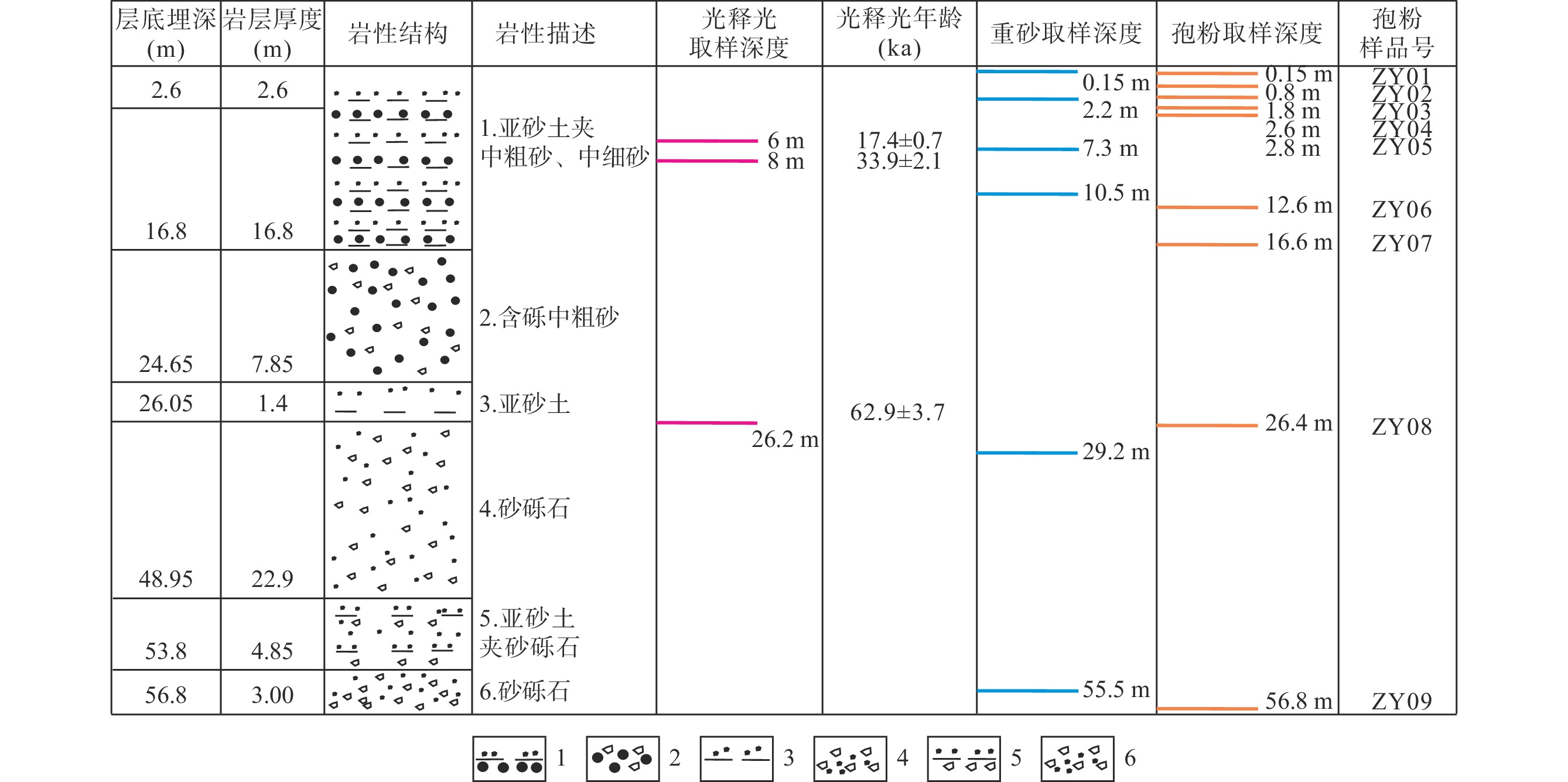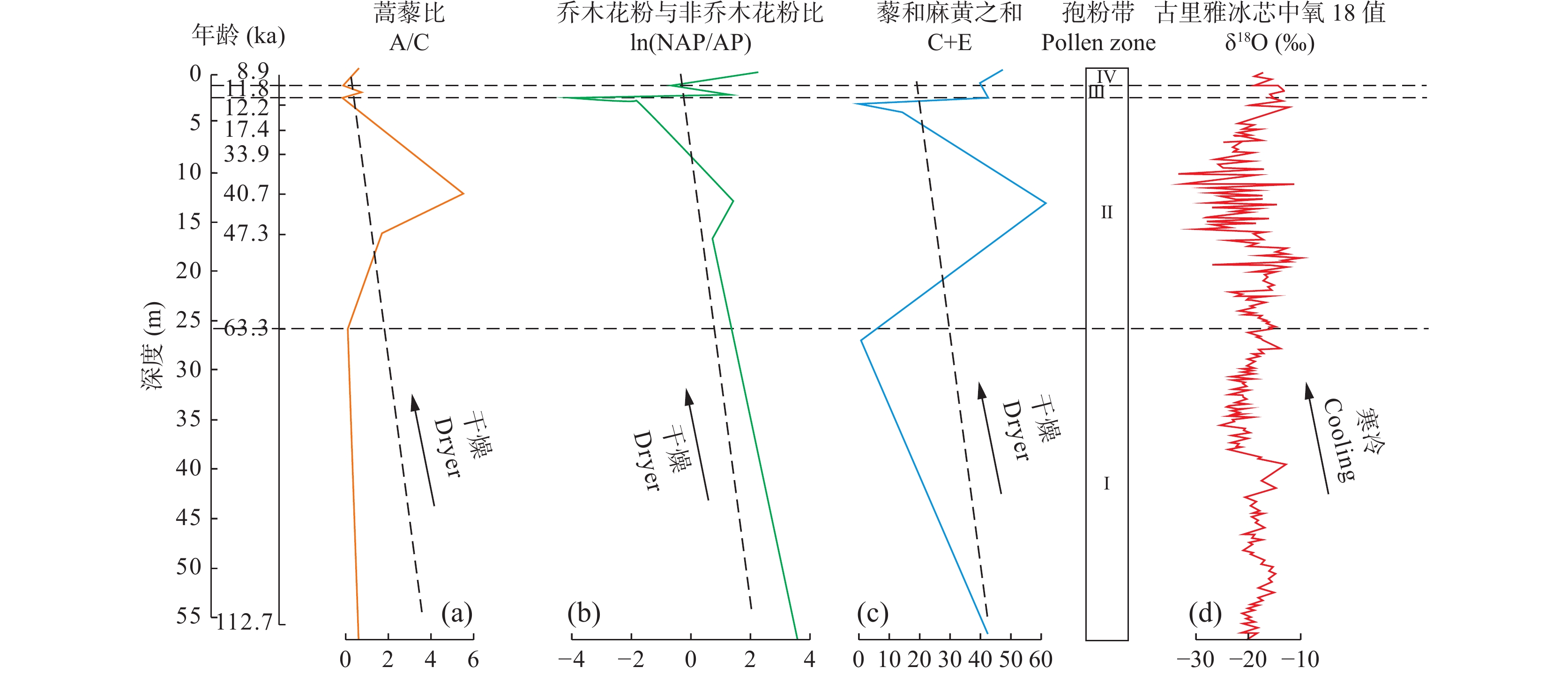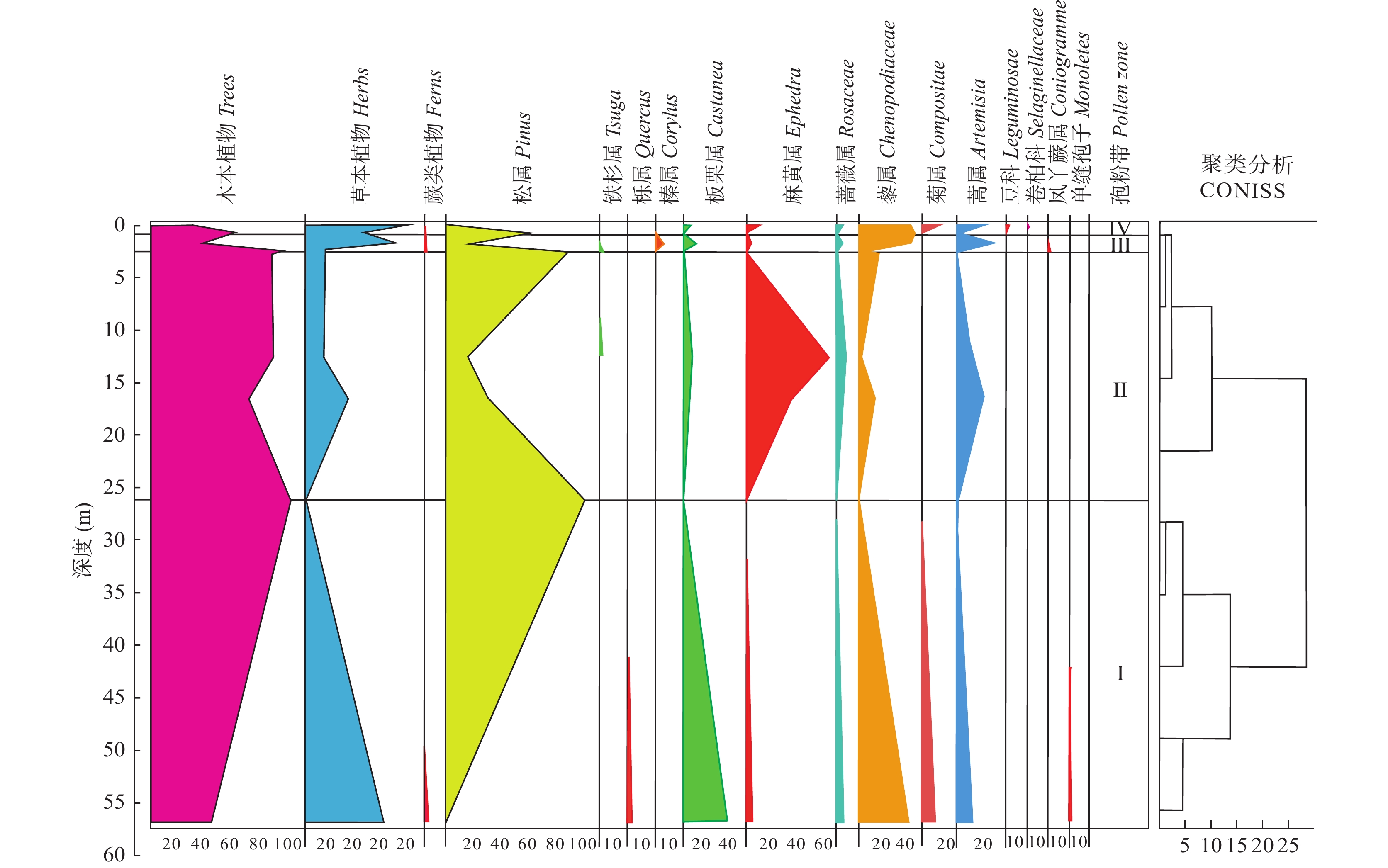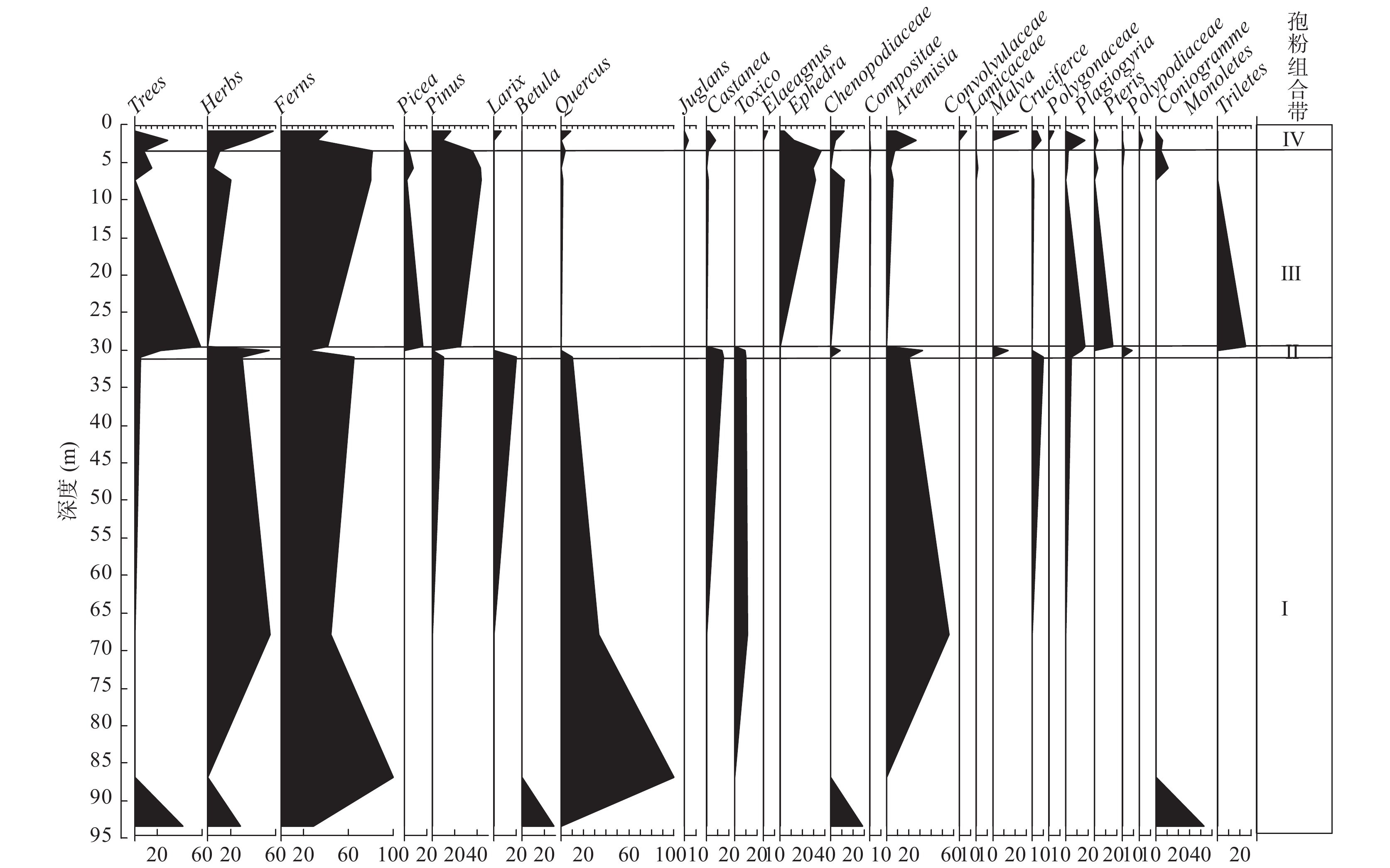Climate Changes of Late Pleistocene to Middle Holocene in Zhangye Basin, NW China: Evidence from Pollen and Heavy Mineral
-
摘要:
为确定张掖盆地晚第四纪沉积地层时代和探讨其蕴含的古气候信息,笔者利用孢粉分析、重矿物分析、光释光测年等方法对研究区晚更新世以来气候变化特征进行了重建,并确认了当地全新世和晚更新世地层界限。结果表明:地层自下而上划分为4个孢粉组合带和植被类型及气候特征:①深度为56.8~26.4 m,年龄为112.7~63.3 ka,属末次间冰期,粉组合为松–板栗–藜–菊–蒿,针阔叶混交林草原植被,为晚更新世温暖较湿润气候。②深度为26.4~2.6 m,年龄为63.3~11.8 ka,与末次冰期相当,孢粉组合为松–麻黄–藜–蒿,植被类型为针阔叶混交林草原植被,为晚更新世干燥寒冷气候。③深度为2.6~0.8 m,年龄为11.8~8.9 ka,全新世早期,孢粉组合为松–藜–蒿,稀树针阔叶混交林草原植被,较凉较干气候。④深度为0.8~0.15 m,年龄为8.9~7.8 ka,全新世早期向中期过渡期,孢粉组合为松–藜–菊–蒿,稀树针阔叶混交林草原植被,为温暖较干气候。孢粉组合所揭示的晚更新世—中全新世气候变化特征,对于揭示张掖盆地甚至西北干旱区的古气候变化具有重要意义。
Abstract:In order to explore the paleoclimatic evolution characteristics and stratigraphic age of Zhangye basin, we reconstructed the climate change characteristics of the study area since the late Pleistocene by means of sporopollen analysis, heavy mineral analysis and optical luminescence dating, and confirmed the stratigraphic boundary between Holocene and late Pleistocene. The results show that the strata are divided into four spore–pollen assemblage zones, the vegetation types and climatic characteristics from bottom to top: ① the depth ranges from 56.8 m to 26.4 m (the age is 112.7~63.3 ka), which is the last interglacial period, the sporepollen assemblage is Pinus–Castanea–Chenopodiaceae–Compositae–Artemisia, coniferous and broad–leaved mixed forest steppe vegetation, which is the warm and humid climate in the late Pleistocene. ② the depth ramges from 26.4 m to 2.6 m (the age is 63.3~11.8 ka), which is the last glacial period, the sporepollen assemblage is Pinus–Ephedra–Chenopodiaceae–Artemisia, and the vegetation type is coniferous and broad–leaved mixed forest steppe vegetation, which is the dry and cold climate of late Pleistocene. ③ the depth ranges from 2.6 m to 0.8 m (the age is 11.8~8.9 ka), which is the postglacial,the sporepollen assemblage is Pinus–Chenopodiaceae–Artemisia, mixed broadleaf–conifer forest steppe vegetation, early Holocene cool and dry climate. ④ the depth ranges from 0.8 m to 0.15 m (the age is 8.9~7.8 ka), which is the postglacial, the sporepollen assemblage is Pinus–Chenopodiaceae–Compositae–Artemisia, broadleaf–conifer mixed forest steppe vegetation, which is the warmer and drier climate of Holocene. The late Pleistocene to mid–Holocene climate evolution characteristics revealed by the spore–pollen assemblages are of great significance for revealing the paleoclimate changes in the Zhangye basin and even the arid area of Northwest China.
-
Key words:
- Zhangye basin /
- paleoclimate /
- glacial period /
- sporopollen analysis /
- heavy mineral
-

-
表 1 光释光测年龄结果表
Table 1. The results of OSL dating of the borehole HQ8
深度(m) U(10–6) Th(10–6) K(%) 等效剂量E.D (Gy) 年剂量Dy(Gy/Ka) 含水量(%) 年 龄(ka ) 6.0 1.86±0.07 11.39±0.30 2.17±0.08 69.66±1.12 4.01±0.16 5±1 17.4±0.7 8.4 2.67±0.04 13.55±0.30 2.14±0.06 150.77±6.99 4.45±0.18 5±1 33.9±2.1 26.2 1.19±0.06 6.67±0.26 1.63±0.03 169.91±7.21 2.70±0.11 5±1 62.9±3.7 表 2 内差值法得出孢粉样品深度对应的年龄表
Table 2. The age corresponding to the depth of the sample was obtained by internal difference method
深度(m) 0.15 0.8 1.8 2.6 2.8 6.0 8.4 12.6 16.6 26.2 26.4 56.8 年代(ka) 7.8 8.9 10.5 11.8 12.2 17.4 33.9 40.7 47.3 62.9 63.3 <112.7 表 3 重矿物物源分析表
Table 3. The provenance analysis of heavy minerals
重矿物组成 物源分析 样品编号 岩浆岩矿物 高级变质矿物 低级变质矿物 再造沉积物 ZS01(0.15 m) 自形锆石、磷灰石、金红石、锐钛矿、单斜辉石、普通角闪石、电气石、磁铁矿、石英、长石、白云母 石榴子石、绿帘石、阳起石、绿泥石 白钛石、
蚀变矿物重晶石 主要为岩浆岩和变质岩,少数为再造沉积物 ZS02(2.2 m) 自形锆石、磷灰石、金红石、锐钛矿、单斜辉石、普通角闪石、电气石、磁铁矿、石英、长石、黑云母、白云母 石榴子石、绿帘石、阳起石、绿泥石 白钛石、
蚀变矿物重晶石 主要为岩浆岩和变质岩,少数为再造沉积物 ZS03(7.3 m) 自形锆石、磷灰石、金红石、锐钛矿、单斜辉石、普通角闪石、电气石、钛铁矿、磁铁矿、石英、长石、黑云母、白云母 石榴子石、绿帘石、阳起石、绿泥石 白钛石、
蚀变矿物重晶石 主要为岩浆岩和变质岩,少数为再造沉积物 ZS04(10.5 m) 自形锆石、磷灰石、金红石、锐钛矿、单斜辉石、普通角闪石、榍石、电气石、钛铁矿、磁铁矿、石英、长石、黑云母、白云母 石榴子石、绿帘石、阳起石、绿泥石 白钛石、
蚀变矿物重晶石 主要为岩浆岩和变质岩,少数为再造沉积物 ZS05(29.2 m) 自形锆石、磷灰石、金红石、单斜辉石、普通角闪石、电气石、榍石、铬铁矿、磁铁矿、石英、长石、黑云母、白云母、火山岩屑及花岗岩屑 石榴子石、绿帘石、阳起石、绿泥石 白钛石、
蚀变矿物— 主要来源于岩浆岩和变质岩 ZS06(55.5 m) 自形锆石、磷灰石、金红石、单斜辉石、普通角闪石、电气石、榍石、磁铁矿、石英、长石、黑云母、白云母、火山岩屑及花岗岩屑 石榴子石、绿帘石、蓝闪石、阳起石、绿泥石 白钛石、
蚀变矿物— 主要来源于岩浆岩和变质岩 表 4 重矿物质量百分含量(%)及风化系数
Table 4. The results of the mass percentages of the heavy minerals and coefficient of weathering
稳定性划分 矿物名称 深度(m)(样品编号) 0.15(ZS01) 2.2(ZS02) 7.3(ZS03) 10.5(ZS04) 29.2(ZS05) 55.5(ZS06) 极稳定矿物 锆石 0.62 3.33 2.29 1.52 0.73 1.39 金红石 0.06 0.72 0.43 0.13 0.02 0.26 锐钛矿 — 0.01 0.01 — — — 电气石 0.21 0.43 0.90 0.12 — — 稳定矿物 白钛石 0.01 0.20 0.45 0.17 0.04 1.92 黄铁矿 0.01 — — — 0.05 0.01 赤褐铁矿 43.91 51.04 53.24 57.22 12.18 35.32 磁铁矿 1.68 3.96 3.03 3.56 24.09 15.61 重晶石 0.09 1.11 2.51 1.49 — — 钛铁矿 — — 3.95 9.28 — — 铬铁矿 — — — 0.32 0.10 — 榍石 — — — — 0.20 0.35 较稳定矿物 磷灰石 — 0.06 0.05 0.02 — 0.03 石榴子石 4.12 2.71 9.34 9.60 3.05 8.19 绿帘石 6.19 8.83 8.84 7.00 3.05 16.24 不稳定矿物 单斜辉石 2.50 2.58 1.97 5.63 3.71 1.49 普通角闪石 11.31 9.10 1.32 0.80 9.15 4.13 阳起石 20.62 11.46 3.29 0.92 34.89 8.45 风化系数 0.96 0.57 0.37 0.32 1.44 0.70 表 5 孢粉分析与重矿物风化系数对气候的指示对照表
Table 5. The comparison of the weathering coefficient of heavy minerals and their climatic indicators and palynological analysis results
地层时代 气候 钻孔深度(m) 孢粉特征
(地层从下至上)孢粉反映气候
变化趋势重砂风化系数对孢粉
反映气候变化的佐证全新世 冰后期 0.8~0.15 较少-很多 寒冷干燥-温暖湿润 2.2 m温暖~0.15 m寒冷 2.6~0.8 很多-较少 温暖湿润-寒冷干燥 晚更新世 末次冰期 2.8~2.6 较少-很多 寒冷干燥-温暖湿润 7.3 m比2.2 m温暖 7.3~2.8 较多-较少 温暖湿润-寒冷干燥 10.5~7.3 增加趋势 升温 10.5 m比7.3 m温暖 26.05~10.5 很少-很多 寒冷干燥-温暖湿润 29.2 m寒冷~10.5 m温暖 末次间冰期 29.2~26.05 孢粉含量极少 持续寒冷干燥 53.8~29.2 很多-很少 温暖湿润-寒冷干燥 55.5 m较29.2 m温暖湿润 56.8~53.8 增加趋势 升温 表 6 钻孔HQ8反映的张掖盆地与酒泉盆地、民乐盆地气候演化对比表
Table 6. The comparison of climatic evolution between Zhangye basin and adjacent Jiuquan basin and Minle basin in the HQ8 borehole
时代 酒泉盆地 民乐盆地 张掖盆地 吉兰泰盐湖 黄土高原临夏、
洛川和富县剖面晚更新世早期(末次间冰期) 年龄(ka) 150~60 70.23~55.59 112.2~62.9(深度为56.8~26.2 m) MIS5(85.8~72.1 ka) 128~75 孢粉组合特征 孢粉组合特征:木本植物主要有松属、桦属、柳属;草本植物以耐旱的蒿、藜、豆科、蔷薇为主,森林草原景观(苏建平等,2005) 气候由间冰期的暖湿气候完全转换成了干冷的特点,波动不是很大,约在60.76 ka 附近最为干冷(Li et al.,2011;王丽媛等,2018) 对应本次研究的26.2 m,年龄是(62.9±3.7) ka 孢粉含量极低。气候干燥寒冷 森林草原,湿度较高 临夏、洛川和富县的末次间冰期的植被中,发现了一些跨越温带和亚热带的树种‚如栾树、漆树、枫杨、黄连木‚以及亚热带树种如铁杉、化香、山核桃、枫香、黄杞等(李秉成等,2004) 气候特征 气候暖湿润,植被茂盛 气候由暖湿转为干冷 气候温暖湿润 黄土高原及其毗邻地区晚更新世气候变化与全球变化是同步的‚温暖湿润 晚更新世中期(末次冰期) 年龄(ka) 60~40 55.59~23.60 62.9~33.9(深度26.4~8.4 m) MIS4、MIS3(71.9~29.5 ka) 黄土高原西部黄土剖面46.4~29 ka 孢粉组合特征 孢粉组合特征:木本植物少见,草本植物有少量蒿、藜、麻黄(苏建平等, 2005) 气温回升,降水增加,冬季风表现得不强烈,但在40.61 ka和53.34 ka 附近依然较为干冷(Li et al.,2011;王丽媛等,2018) 对应本次研究的8.4m,年龄是(33.9±3.7) ka。孢粉含量较之前的增加。气候依然较为干冷 周围植被主要以蒿属、藜科、麻黄属为主的典型草原/荒漠草原,荒漠植被有大面积的发育,附近山地有松林发育和胡桃科为主的落叶林(彭卫,2018) 花粉浓度较低,反映当时森林草原植被覆盖较低。46.4~46.2 ka 森林草原阶段。46~29 ka 针叶林阶段。这时段以松和云杉占优势‚花粉浓度较高‚应是针叶林繁盛时期(唐领余等,2007) 气候特征 寒冷干燥,冷期 气温较为回升,但是整体寒冷干燥 气候冷干为主 气候寒冷后较湿润 晚更新世晚期(末次冰期) 年龄(ka) 40~12 23.60~10.22 33.9~10.5(深度为8.4~1.8 m) MIS2(29.5~12 ka) 29~11.7 ka 孢粉组合特征 孢粉组合特征:木本植物有云杉、松、桑、木樨、桦、柳、榆等,草本植物有蒿、藜、麻黄、禾本科、十字花科、茄科(苏建平等,2005) 该段分为盛冰期与晚冰期两个阶段。盛冰期(23.60~13.78 ka )该阶段属于晚更新世末次冰期中的盛冰期,该阶段气候异常寒冷(Li et al.,2011;王丽媛等,2018) 对应本次研究的6.0 m,年龄是(17.4±0.7) ka。孢粉含量极低 孢粉以蒿属、藜科、禾本科为主的典型草原,有零星荒漠分布,附近山地松林、云杉林发育有落叶榆属疏林发育
(彭卫,2018)29~23.4 ka 森林-森林草原急剧变化阶段。23.4~20.4 ka 稀疏草原阶段。花粉浓度很低‚主要是草本植物,反映为稀疏草原植被。进入末次盛冰期(LGM)。20.4~17 ka草原向荒漠草原方向演化。花粉浓度很低。17~13.2 ka荒漠草原-森林阶段。11.7 ka以后孢粉贫乏‚植被又向荒漠草原发展(唐领余等,2007) 气候特征 12~10 ka 之间 由于新仙女木事件气候转冷。气候冷热频繁交替,以温暖湿润为主 气候变为异常寒冷 气候干燥寒冷 气候整体干燥寒冷 续表6 时代 酒泉盆地 民乐盆地 张掖盆地 吉兰泰盐湖 黄土高原临夏、洛川和富县剖面 全新世
(冰后期)年龄(ka) 10~7 ka 10.22 ka~ 10.5~7.8 ka(深度1.8~0.15 m) 12~9 ka 11.7~7.5 ka 孢粉组合特征 木本花粉云杉属、冷杉属、松属桦属、杨属等、铁杉属;草本植物花粉有麻黄属、蒿属、藜属、菊科(苏建平等,2005) 全新世时期,气温急剧升高,降雨也随着变多(Li et al.,2011;王丽媛等,2018) 对应本次研究的深度2.6 m,孢粉含量很多 以蒿属、藜科为主的典型草原为主,荒漠扩张
(彭卫,2018)11.7~8.8 ka 荒漠草原植被类型。花粉浓度低,以草本植物为主,主要有蒿属、禾本科、菊科,表明发育稀疏草原-荒漠草原植被,可能表明晚冰期的气候寒冷干旱。后期木本植物增加‚显示温度湿度增高。8.8~7.5 ka 疏林草原阶段。木本植物开始增加,尤其是松属增多,落叶阔叶树种零星出现。草本植物蒿属、禾本科、菊科较多。呈现疏林草原或森林草原景观(唐领余等,2007) 气候特征 在10~7 ka ,气候转温暖湿润 气候转暖后干燥寒冷后转暖 气候转暖后干燥寒冷后转暖 温度上升,温暖较干燥 气候总体特征为温凉略干 表 7 钻孔HQ8、ZY-1孢粉带反映的气候特征对比表
Table 7. Comparative table of climatic characteristics of pollen zones in borehole HQ8 and ZY-1
孢粉带 地层深度(m) 代表性孢粉 气候特征 钻孔HQ8 钻孔ZY-1 钻孔HQ8 钻孔ZY-1 钻孔HQ8 钻孔ZY-1 Ⅰ 56.8~26.4 93.4~31 松-板栗-藜-菊-蒿 落叶松-栎-蒿 温暖湿润-干冷 气候较干冷 Ⅱ 26.4~2.6 31~3.5 松-麻黄-藜-蒿 松-蒿-瘤足蕨-凤尾蕨-云杉-麻黄-藜 温暖湿润 较暖稍润-温暖湿润 Ⅲ 2.6~0.8 松-藜-蒿 较凉干旱 Ⅳ 0.8~0.15 3.5~0.8 松-藜-菊-蒿 松-麻黄-蒿-瘤足蕨 温暖较干旱 向暖干方向发展 -
[1] 常婧. 黑河中游孢粉记录及第四纪环境变化研究[D]. 兰州: 兰州大学, 2016.
CHANG Jing. Pollen records and the Quaternary environment change in the middle reach of Heihe River[D]. Lanzhou: Lanzhou University, 2016.
[2] 陈雪梅. 黑河流域晚全新世农业活动及环境演变的孢粉学研究[D]. 兰州: 兰州大学, 2012.
CHEN Xuemei. Palynological Study on Agricultural Activities and Environmental Evolution during the Late Holocene in Heihe River Basin, NW China[D]. Lanzhou: Lanzhou University, 2012.
[3] 崔延华, 宋悦, 粟晓玲. 祁连山区气候变化对黑河出山径流的影响[J]. 人民黄河, 2017, 39(5): 15-20 doi: 10.3969/j.issn.1000-1379.2017.05.005
CUI Yanhua, SONG Yue, SU Xiaoling. Impacts of Climate Change in Qilian Mountain Area on Run off in the Heihe River Basin[J]. Yellow River, 2017, 39(5): 15-20. doi: 10.3969/j.issn.1000-1379.2017.05.005
[4] 冯嘉兴, 蒙琪, 王茜. 黑河干流中游地区近40年来地下水环境变化特征及其成因[J]. 西北地质, 2023, 56(4): 243−253.
FENG Jiaxing, MENG Qi, WANG Xi. Characteristics and Causes of Groundwater Environment Changes in the Middle Reaches of the Mainstream of the Heihe River in Recent 40 Years[J]. Northwestern Geology, 2023, 56(4): 243−253.
[5] 赖忠平, 欧先交. 光释光测年基本流程[J]. 地理科学进展, 2013, 32(5): 683-693 doi: 10.11820/dlkxjz.2013.05.001
LAI Zhongping, OU Xianjiao. Basic procedures of optically stimulated luminescence (OSL) dating[J]. PROGRESS IN GEOGRAPHY, 2013, 32(5): 683-693. doi: 10.11820/dlkxjz.2013.05.001
[6] 李育, 王乃昂, 李卓仑, 等. 石羊河流域全新世孢粉记录及其对气候系统响应争论的启示[J]. 科学通报, 2011, 2: 161-173.
LU K Q, GAN X, MIN L, et al. Pollen spectrum, a cornerstone for tracing the evolution of the eastern Central Asian desert[J]. Quaternary Science Reviews, 2018, 186: 111-122.
[7] 李吉均. 青藏高原隆升与晚新生代环境变化[J]. 兰州大学学报 (自然科学版), 2013, 49(2): 154-159.
LI Jijun. Uplift and late Cenozoic environmental changes of the Tibetan Plateau[J]. Journal of Lanzhou University (Natural Sciences), 2013, 49(2): 154–159.
[8] 梁鹏飞, 辛惠娟, 李宗省, 等. 祁连山黑河径流变化特征及影响因素研究[J]. 干旱区地理, 2022, 4: 1-13 doi: 10.12118/j.issn.10006060.2021.535
LIANG Pengfei, XIN Huijuan, LI Zongxing, et al. Runoff variation characteristics and influencing factors in the Heihe River Basin in the Qilian Mountains[J]. ARID LAND GEOGRAPHY, 2022, 4: 1-13. doi: 10.12118/j.issn.10006060.2021.535
[9] 樊隽轩, 王向东, 陈中强, 等. 国际地层委员会动态与《国际年代地层表》(2021/07 版)[J]. . 地层学杂志, 2021, 45(3): 460-466.
FAN Junxuan, WANG Xiangdong, CHEN Zhongqiang, et al. International Commission on Stratigraphy and International chronostratigraphic table (2021/07)[J]. Journal of Stratigraphy, 2021, 45(3): 460–466.
[10] 刘瑾, 陈兴强, 王平, 等. 渭河-三门峡盆地三门组沉积充填特征、物源区及其构造意义[J]. 地球科学, 2020, 45(7): 2673-2683
LIU Jin, CHEN Xingqiang, WANG Ping, et al. Sedimentary Characteristics, Provenance and Tectonic Significance of the Sanmen Formation in Weihe-Sanmenxia Basin[J]. Earth Science, 2020, 45(7): 2673-2683.
[11] 刘淼, 张渝金, 孙守亮, 等. 辽西金羊盆地北票组孢粉组合及其时代和古气候意义[J]. 地球科学, 2019, 46(1): 287-292.
LIU Miao,ZHANG Yujin,SUN Shouliang,et al.Palynological Assemblages of Beipiao Formation in Jinyang Basin of WestLiaoning, and Their Age and Paleoclimatic Significances[J].Earth Science,2019,46(1):287-292.
[12] 李秉成, 孙建中. 黄土高原晚更新世的植被与气候环境[J]. 地理研究, 2004, 23(5): 641-648 doi: 10.3321/j.issn:1000-0585.2004.05.008
LI Bingcheng, SUN Jianzhong. Vegetation and climate environment during the late Pleistocene in Loess Plateau‚China[J]. GEOGRAPHICAL RESEARCH, 2004, 23(5): 641-648. doi: 10.3321/j.issn:1000-0585.2004.05.008
[13] 牛东风, 李保生, 王丰年, 等. 不同沉积相重矿物组成及其对气候的指示—以米浪沟湾全新统MGS1层段为例[J]. 实验室研究与探索, 2015, 34(7): 7-11.
NIU Dong-feng, LI Bao-sheng, WANG Feng-nian, et al. CHEN Min. Heavy Mineral Composition and Its Climatic Indication for the MGS1Segment in the Holocene in Milanggouwan[J]. RESEARCH AND EXPLORATION IN LABORATORY. 2015, 34(7): 7-1
[14] 彭卫. 孢粉记录的黄土高原西部更新世晚期人类活动的环境背景研究. [D]兰州: 兰州大学, 2018.
PENG Wei. Environmental background of human activities during the late Pleistocene revealed by pollen records from the western Loess Plateau.[D]. Lanzhou: Lanzhou University, 2018.
[15] 祁晓凡, 李文鹏, 崔虎群, 等. 黑河流域中游盆地地表水与地下水转化机制研究[J]. 水文地质工程地质, 2022, 49(3): 29-43 doi: 10.16030/j.cnki.issn.1000-3665.202202003
QI Xiaofan, LI Wenpeng, CUI Huqun, et al. Study on the conversion mechanism of surface water and groundwater in the middle reaches of the Heihe River Basin[J]. HYDROGEOLOGY & ENGINEERING GEOLOGY, 2022, 49(3): 29-43. doi: 10.16030/j.cnki.issn.1000-3665.202202003
[16] 祁晓凡, 李文鹏, 李海涛, 等. 黑河流域气象要素与全球性大气环流特征量的多尺度遥相关分析[J]. 干旱区地理, 2017, 40(3): 564-572
QI Xiaofan, LI Wenpeng, LI Haitao, et al. Multi-scale teleconnections between meteorological elements of Heihe River Basin and global climate indices[J]. Arid Land Geography, 2017, 40(3): 564-572.
[17] 施雅风, 刘晓东, 李炳元, 等. 距今40- 30 ka青藏高原特强季风事件及其发差周期关系[J]. , 科学通报, 1997, 44(14) : 1475-1480.
SHI Yafeng, LIU Xiaodong, LI Bingyuan, et al. The relationship between extra-strong monsoon events and their periodicity over the Qinghai-Tibet Plateau 40-30 ka ago[J]. Chinese Science Bulletin, 1997, 44(14): 1475–1480.
[18] 苏建平, 仵彦卿, 李麒麟, 等. 第四纪以来酒泉盆地环境演变与祁连山隆升[J]. 地球学报, 2005, 26(5): 443-448
SU Jianping, WU Yanqing, LI Qilin, et al. Environmental Evolution of the Jiuquan Basin and Its Relation with the Uplift of the Qilian Mountains since the Quaternary[J]. ACTA GEOSCIENTICA SINICA, 2005, 26(5): 443-448.
[19] 唐领余, 李春海, 安成邦, 等. 黄土高原西部4万多年以来植被与环境变化的孢粉记录[J]. 古生物学报‚2007, 46(1): 45-61
TANG Lingyu, LI Chunhai‚AN Chengbang, et al. VEGETATION HISTORY OF THE WESTERN LOESS PLATEAU OF CHINA DURING THE LAST40ka BASED ON POLLEN RECORD[J]. Acta Palaeontologica Sinica‚2007, 46(1): 45-61.
[20] 韦一, 杨兵, 夏浩东, 等. 抚顺盆地中—晚始新世古植被与古气候[J]. 地球科学, 2021, 46(5): 1848-1861
WEI Yi, YANG Bing, XIA Haodong, et al. Paleovegetation and Paleoclimate during Mid-Late Eocene in Fushun Basin[J]. Earth Science, 2021, 46(5): 1848-1861.
[21] 王具文, 张旭儒, 宁天祥, 等. 张掖盆地地热资源流体化学特征研究[J]. 地下水, 2019, 41(4): 17-19
WANG Juwen, ZHANG Xuru, NING Tianxiang, et al. Study on Fluid Chemical Characteristics of Geothermal Resources in Zhangye Basin[J]. Ground water, 2019, 41(4): 17-19.
[22] 王文祥, 李文鹏, 蔡月梅, 等. 黑河流域中游盆地水文地球化学演化规律研究[J]. 地学前缘, 2021, 28(4): 184-193
WANG Wenxiang, LI Wenpeng, CAI Yuemei, et al. The hydrogeochemical evolution of groundwater in the middle reaches of the Heihe River Basin[J]. Earth Science Frontiers, 2021, 28(4): 184-193.
[23] 王丽媛, 程捷, 韩金, 等. 河西走廊民乐盆地晚更新世以来的气候变迁[J]. 中国矿业, 2018, 27: 80-89 doi: 10.12075/j.issn.1004-4051.2018.S1.020
WANG Liyuan, CHENG Jie, HAN Jin, et al. Climate changes during the Late Pleistocene of Minle basin in Hexi corridor [J]. CHINA MINING MAGAZINE, 2018, 27: 80-89. doi: 10.12075/j.issn.1004-4051.2018.S1.020
[24] 袁林旺, 陈晔, 周春林, 等. 柴达木盆地自然伽玛曲线与古里雅冰芯记录的末次间冰期以来气候环境变化过程的对比[J]. 冰川冻土, 2000, 22(4): 327-332
YUAN Linwang, CHEN Ye, ZHOU Chunlin‚et al. Correlation of Environmental and Climatic Change Between Qaidam Basin Gamma Ray Logging Curve and Guliya Ice Core δ18 O Record Since the Last Interglacial Cycle[J]. JOURNAL OF GLACIOLOGY AND GEOCRYOLOGY, 2000, 22(4): 327-332.
[25] 姚檀栋. 古里雅冰芯中末次间冰期以来气候变化记录研究[J]. 中国科学, 1997, 27(5): 447-452.
YAO Tandong, SHI Yafeng, QIN Dahe, et al. Climate change records since the last interglacial period in the Gurya ice core[J]. Sciencese in China, 1997, 27(5): 447-452.
[26] 张克旗, 吴中海, 吕同艳, 等. 光释光测年法-综述及进展[J]. 地质通报, 2015, 34(1): 183-203
ZHANG Keqi, WY Zhonghai, LV Tongyan, et al. Review and progress of OSL dating. Geological Bulletin of China, 2015, 34(1): 183-203
[27] IGOR O, LARS W, ACHIM B, et al. An annually resolved record of Western European vegetation response to Younger Dryas cooling[J]. Quaternary Science Reviews, 2020, 231: 1-15.
[28] LI M Y, ZHANG S R , XU Q H, et al. Spatial patterns of vegetation and climate in the North China Plain during the Last Glacial Maximum and Holocene climatic optimum[J]. Science China Earth Sciences, 2019, 8: 1279-1287.
[29] LI XQ, Sun N, DODSON J, et al. The impact of early smelting on the environment of Huoshiliang in Hexi Corridor, NW China, as recorded by fossil charcoal and chemical elements[J]. Palaeogeography Palaeoclimatology Palaeoecology, 2011, 305: 329-336. doi: 10.1016/j.palaeo.2011.03.015
[30] MA Q F, ZHU L P, WANG X M, et al. Late glacial and Holocene vegetation and climate variations at Lake Tangra Yumco, central Tibetan Plateau[J]. Global and Planetary Change, 2019, 174 : 16-25. doi: 10.1016/j.gloplacha.2019.01.004
[31] MA Z B, CHENG H, TAN M, et al. Timing and structure of the Younger Dryas event in northern China[J]. Quaternary Science Review, 2012, 4: 83-93.
[32] Morton A C, Hallsworth R C. Processes controlling the composition of heavy mineral assemblages in sandstones[J]. Sedimentary Geology, 1999, 124: 3−29.
[33] Prescott J R, Hutton J T. Cosmic ray contributions to dose rates for luminescence and ESR dating: Large depths and long-term time variations[J]. Radiation Measurements, 1994, 23(2−3): 497−500.
[34] Thompson L G, Mosley-Thompson E, Davis M E, et al. Holocene-Late Pleistocene Climate Ice Core Records from Qinghai-Tibetan Plateau[J]. Science,1989, 246(4929): 474−477.
[35] WANG L S, WANG X Q, SHEN J H, et al. Late Pleistocene environmental information on the Die xi paleodammed lake of the upper Minjiang River in the eastern margin of the Tibetan Plateau. China[J]. J. Mt. Sci, 2020, 17(5): 1172-1187. doi: 10.1007/s11629-019-5573-x
[36] WU F L, FANG X M, MIAO Y F, et al. Environmental indicators from comparison of sporopollen in early Pleistocene lacustrine sediments from different climatic zones[J]. Chinese Science Bulletin, 2010, 55: 2981-2988. doi: 10.1007/s11434-010-4002-x
-



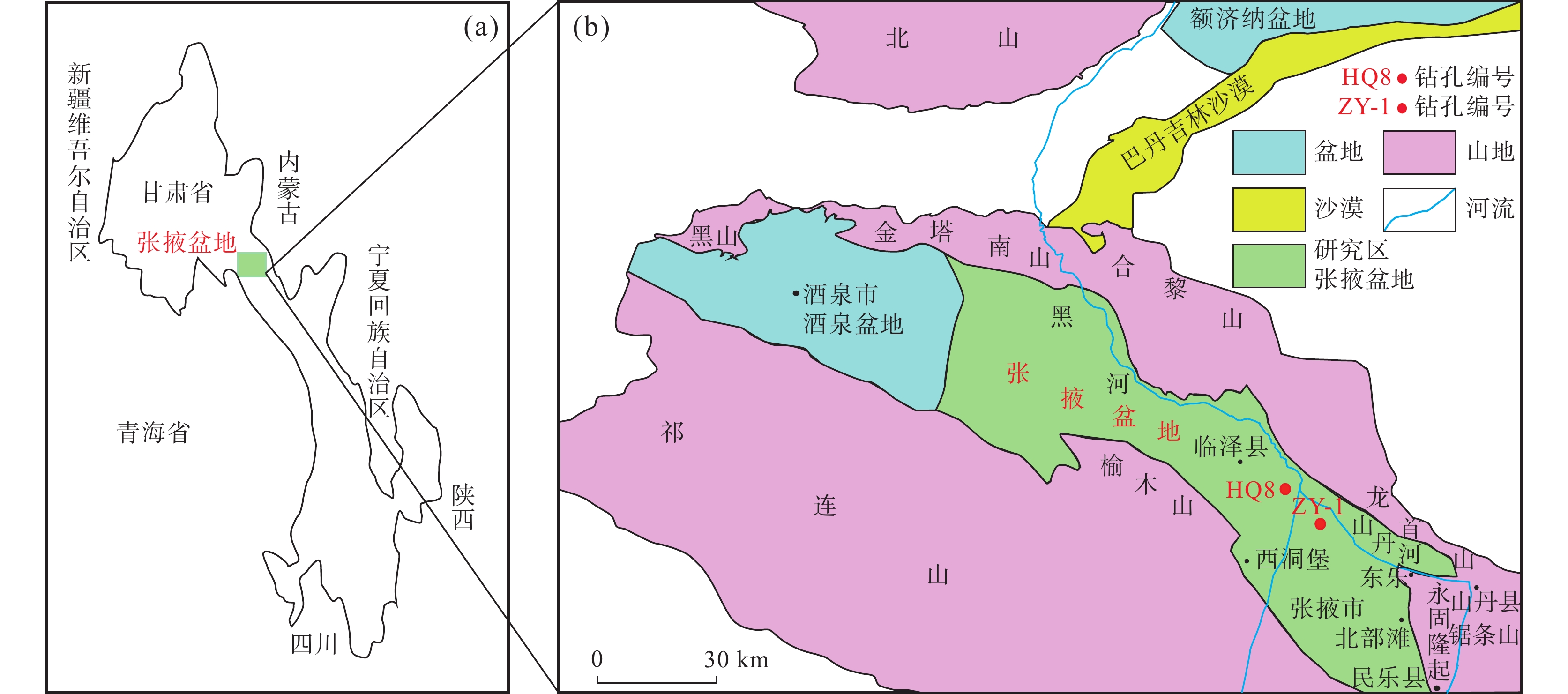
 下载:
下载:
